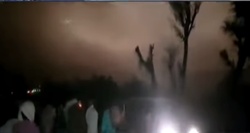A second round is expected to hit Uttar Pradesh and Rajasthan by Saturday, after dust storms, followed by thunder showers, led to the death of at least 127 people and injured over 100 people in many parts of northern India in the last 24 hours.

A few states like Rajasthan and Uttar Pradesh, which are still reeling under the effects of the deadly dust storms, have been asked to brace up for another storm that is expected to hit parts of northern India by Saturday.
The warning was issued by the meteorological department on Thursday.
The severe thunderstorms that lashed many parts of the country on Wednesday night killed at least 127 people and left a trail of destruction, with houses flattened trees uprooted and twisted electricity poles.
The storm also led to several road accidents in Rajasthan and in other parts of Punjab, Delhi, Haryana, and west Uttar Pradesh.
The maximum devastation occurred in Uttar Pradesh where the storms claimed 73 lives, with 46 deaths reported from Agra district alone.
As many as 39 people died in Rajasthan, followed by seven in Telangana, four in Uttarakhand and two each in Jharkhand and Punjab.
With the fury of the storms and rains continuing for several hours in many places, the full extent of the damage was known only on Thursday.
“Concrete houses came down like pack of cards one after the other. Trees, streetlights and whatever stood taller than a few feet were flattened by the winds. We took out victims from debris of houses and ferried them to hospitals on motorcycles,” The Times of India quoted Narendra Sharma, the SHO of Kheragarh police station in Agra district, as saying after a night of rescue operations.
These dust storms were caused by climate change, mainly because of the moisture, warm temperatures and a disturbed atmosphere, which in turn pushes the warm moist air upwards.
While in Rajasthan unusually high temperatures caused the air close to the ground to heat up and move upwards, in Haryana and the adjoining areas, cyclonic circulation pushed the warm air upwards, following which storm clouds were formed, say experts.
In the eastern parts of the country, the high moisture levels were caused by winds blowing in from Bay of Bengal, especially in the eastern parts of UP and Bihar, while in the west, a system of low pressure brought moisture from Eurasian water bodies.
The dust storm was caused by the air carrying sand along with it as it moves upward.
The thunderstorm was caused by the incursion of moisture because of the western disturbance. The storms also witnessed updraught, which is the upward movement of warm air and downdraught, the downward current of air along with rain.
The report by the Hindustan times said the updraught and downdraught was happening simultaneously in different areas due to the wind shear, which is the rapid variation in wind velocity and direction. This means that the downward draught itself whipped up another updraught that led to another thunderstorm — creating a chain of thunderstorms.
 A few states like Rajasthan and Uttar Pradesh, which are still reeling under the effects of the deadly dust storms, have been asked to brace up for another storm that is expected to hit parts of northern India by Saturday.
A few states like Rajasthan and Uttar Pradesh, which are still reeling under the effects of the deadly dust storms, have been asked to brace up for another storm that is expected to hit parts of northern India by Saturday.






.webp)














